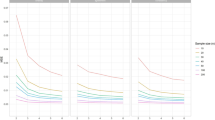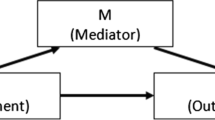Abstract
A semicompeting risks problem involves two-types of events: a nonterminal and a terminal event (death). Typically, the nonterminal event is the focus of the study, but the terminal event can preclude the occurrence of the nonterminal event. Semicompeting risks are ubiquitous in studies of aging. Examples of semicompeting risk dyads include: dementia and death, frailty syndrome and death, disability and death, and nursing home placement and death. Semicompeting risk models can be divided into two broad classes: models based only on observables quantities (class \(\mathcal {O}\)) and those based on potential (latent) failure times (class \(\mathcal {L}\)). The classical illness-death model belongs to class \(\mathcal {O}\). This model is a special case of the multistate models, which has been an active area of methodology development. During the past decade and a half, there has also been a flurry of methodological activity on semicompeting risks based on latent failure times (\(\mathcal {L}\) models). These advances notwithstanding, the semicompeting risks methodology has not penetrated biomedical research, in general, and gerontological research, in particular. Some possible reasons for this lack of uptake are: the methods are relatively new and sophisticated, conceptual problems associated with potential failure time models are difficult to overcome, paucity of expository articles aimed at educating practitioners, and non-availability of readily usable software. The main goals of this review article are: (i) to describe the major types of semicompeting risks problems arising in aging research, (ii) to provide a brief survey of the semicompeting risks methods, (iii) to suggest appropriate methods for addressing the problems in aging research, (iv) to highlight areas where more work is needed, and (v) to suggest ways to facilitate the uptake of the semicompeting risks methodology by the broader biomedical research community.



Similar content being viewed by others
References
Aalen OO (1994) Effects of frailty in survival analysis. Stat Methods Med Res 3:227–243
Bandeen-Roche K, Liang KY (2002) Modelling multivariate failure time associations in the presence of a competing risk. Biometrika 89:299–314
Boyd CM, Fortin M (2010) Future of multimorbidity research: how should understanding of multimorbidity inform health system design? Public Health Rev 32:451–474
Cappola AR, O’Meara ES, Guo W, Bartz TM, Fried LP, Newman AB (2009) Trajectories of dehydroepiandrosterone sulfate predict mortality in older adults: the cardiovascular health study. J Gerontol Med Sci 64:1268–1274
Chen Y-H (2012) Maximum likelihood analysis of semicompeting risks data with semiparametric regression models. Lifetime Data Anal 18:36–57
Cheng Y, Fine JP (2008) Nonparametric estimation of cause-specific cross hazard ratio with bivariate competing risks data. Biometrika 95:233–40.
Cheng Y, Fine JP, Kosorok MR (2007) Nonparametric association analysis of bivariate competing-risks data. J Am Stat Assoc 102:1407–1415
Day R, Bryant J, Lefkopoulou M (1997) Adaptation of bivariate frailty models for prediction, with application to biological markers as prognostic indicators. Biometrika 84:45–56
Ding AA, Shi G, Wang W, Hsieh J-J (2009) Marginal regression analysis for semi-competing risks data under dependent censoring. Scand J Stat 36:481–500
Elashoff RM, Li G, Li N (2007) An approach to joint analysis of longitudinal measurements and competing risks failure time data. Stat Med 26:2813–2835
Elashoff RM, Li G, Li N (2008) A joint model for longitudinal measurements and survival data in the presence of multiple failure types. Biometrics 64:762–771
Fine JP, Gray RJ (1999) A proportional hazards model for the subdistribution of a competing risk. J Am Stat Assoc 94:496–509
Fine JP, Jiang H, Chappell R (2001) On semi-competing risks data. Biometrika 88:907–919
Fix E, Neyman J (1951) A simple stochastic model to recovery, relapse, death and loss of patients. Hum Biol 23:204–241
Frangakis CE, Rubin DB, An M-W, Mackenzie E (2007) Principal stratification designs to estimate input data missing due to death. Biometrics 63:641–662
Fries JF (1980) Aging, natural death, and the compression of morbidity. N Engl J Med 303:1369–1370
Gulati R (2011) what if i don’t treat my psa-detected prostate cancer? Answers from three natural history models. Cancer Epidemiol Biomark Prev 55:3–24
Henderson R, Diggle P, Dobson A (2000) Joint modelling of longitudinal measurements and event time data. Biostatistics 1:465–480
Hernan MA, Alonso A, Logroscino G (2008) Cigarette smoking and dementia: potential selection bias in the elderly. Epidemiology 19:448–450
Hernan MA (2010) The hazards of hazard ratios. Epidemiology 21:13–15
Hougaard P (1999) Multi-state models: a review. Lifetime Data Anal 5:239–264
Hsieh J-J, Huang Y-T (2012) Regression analysis based on conditional likelihood approach under semi-competing risks data. Lifetime Data Anal 103:302320
Hu W, Li G, Li N (2009) A bayesian approach to joint analysis of longitudinal measurements and competing risks failure time data. Stat Med 28:1601–1619
Kaplan GA, Haan MN, Wallace RB (1999) Understanding changing risk factor associations with increasing age in adults. Annu Rev Public Health 20:89–108
Lakhal L, Rivest LP, Abdous B (2008) Estimating survival and association in a semicompeting risks model. Biometrics 64:180–188
Larson MG, Dinse GE (1985) A mixture model for the regression-analysis of competing risks data. Appl Stat J R Stat Soc Ser C 34:201–211
Li N, Elashoff RM, Li G, Saver J (2010) Joint modeling of longitudinal ordinal data and competing risks survival times and analysis of the ninds rt-pa stroke trial. Stat Med 29:546–557
Lin DY, Robins JM, Wei LJ (1996) Comparing two failure time distributions in the presence of dependent censoring. Biometrika 83:381–393
Lin OS, Kozarek RA, Schembre DB et al (2006) Screening colnoscopy in very elderly patients: prevalence of neoplasia and estimated impact on life expectancy. JAMA 295:2357–2365
Marengoni A, Angleman S, Melis R et al (2011) Aging with multimorbidity: a systematic review of the literature. Aging Res Rev 10:430–439
Ng SK, McLachlan GJ (2003) An em-based semi-parametric mixture model approach to the regression analysis of competing-risks data. Stat Med 22:1097–1111
Peng L, Fine JP (2006) Rank estimation of accelerated lifetime models with dependent censoring. J Am Stat Assoc 101:1085–1093
Peng L, Fine JP (2007) Regression modeling of semicompeting risks data. Biometrics 63:96–108
Peterson AV Jr (1976) Bounds for a joint distribution function with fixed sub-distribution functions: application to competing risks. Proc Natl Acad Sci 73:11–13
Peterson B, Harrell FE (1990) Partial proportional odds models for ordinal response variables. Appl Stat J R Stat Soc Ser C 39:205–217
Prentice RL, Kalbfleisch JD, Peterson AV Jr, Flournoy N, Farewell VT, Breslow NE (1978) The analysis of failure times in the presence of competing risks. Biometrics 34:541–554
Putter H (2011) Special issue about competing risks and multi-state models. J Stat Softw 38:1–4
Rantanen T, Guralnik JM, Foley D, Masaki K, Leveille S, Curb JD, White L (1999) Midlife hand grip strength as a predictor of old age disability. JAMA 281:558–560
Robins JM (1987) A new approach to causal inference in mortality studies with sustained exposure periods—application to control of the healthy worker survivor effect. Comput Mathl Appl 14:923–945
Robins JM (1995a) An analytic method for randomized trials with informative censoring: part i. Lifetime Data Anal 1:241–254
Robins JM (1995b) An analytic method for randomized trials with informative censoring: part ii. Lifetime Data Anal 1:417–434
Scheike TH, Zhang M-J (2008) Flexible competing risks regression modeling and goodness-of-fit. Lifetime Data Anal 14:464–483
Scheike TH, Sun Y, Zhang MJ, Jensen TK (2010) A semiparametric random effects model for multivariate competing risks data. Biometrika 97:133–145
Shih JH, Albert PS (2010) Modeling familial association of ages at onset of disease in the presence of competing risk. Biometrics 66:1012–1023
Slud EV, Rubinstein LV (1983) Dependent competing risks and summary survival curves. Biometrika 70:643–649
Tsiatis A (1975) A nonidentifiability aspect of the problem of competing risks. Proc Natl Acad Sci 72:20–22
Varadhan R, Weiss CO, Segal JB, Wu AW, Scharfstein D, Boyd C (2010) Evaluating health outcomes in the presence of competing risks: a review of statistical methods and clinical applications. Med Care 48:96–105
Vaupel JW, Yashin AI (1985) Heterogeneitys ruses: some surprising effects of selection on population dynamics. Am Stat 39:176–185
Walter LC, Bertenthal D, Lindquist K, Konety BR (2006) Psa screening among elderly men with limited life expectancies. J Am Med Assoc 296:2336–2342
Walter LC, Covinsky KE (2001) Cancer screening in elderly patients: a framework for individualized decision making. J Am Med Assoc 285:2750–2756
Wang W (2003) Estimating the association parameter for copula models under dependent censoring. J R Stat Soc 65:257–274
Weiss CO, Segal JB, Varadhan R (2012) Assessing the applicability of trial evidence to a target sample in the presence of heterogeneity of treatment effect. Pharmacoepidemiol Drug Saf 21:121–129
Welch HG, Albertsen PC, Nease RF, Bubolz TA, Wasson JH (1996) Estimating treatment benefits for the elderly: the effect of competing risks. Ann Intern Med 124:577–584
Xu J, Kalbfeisch JD, Tai B (2010) Statistical analysis of illness-death processes and semicompeting risks data. Biometrics 66:716–725
Xue QL, Walston JD, Fried LP, Beamer BA (2011) Rate of decline in grip strength predicts the risk of falling, physical disability, and frailty: the womens health and aging study. Arch Intern Med 171:1119–1121
Xue QL, Beamer BA, Chaves PHM, Guralnik JM, Fried LP (2010) Heterogeneity in rate of decline in grip, hip, and knee strength and the risk of all-cause mortality: the women’s health and aging study ii. J Am Geriatr Soc 58:2076–2084
Yu B, Ghosh P (2010) Joint modeling for cognitive trajectory and risk of dementia in the presence of death. Biometrics 66:294–300
Zhang JL, Rubin DB (2003) Estimation of causal effects via principal stratification when some outcomes are truncated by death. J Educ Behav Stat 28:353–368
Acknowledgments
Ravi Varadhan is a Brookdale Leadership in Aging Fellow and would like to thank the Brookdale Foundation for their support. The authors would also like to thank the support from the Johns Hopkins Older Americans Independence Center under the NIA/NIH contract P30-AG02133 and the Johns Hopkins Alzheimer’s Disease Research Center, NIA P50 AG005146.
Author information
Authors and Affiliations
Corresponding author
Rights and permissions
About this article
Cite this article
Varadhan, R., Xue, QL. & Bandeen-Roche, K. Semicompeting risks in aging research: methods, issues and needs. Lifetime Data Anal 20, 538–562 (2014). https://doi.org/10.1007/s10985-014-9295-7
Received:
Accepted:
Published:
Issue Date:
DOI: https://doi.org/10.1007/s10985-014-9295-7




